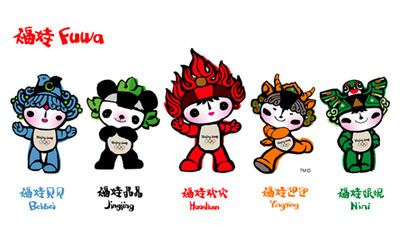Chinese 福娃 Hanyu Pinyin | Literal meaning dolls of blessing Jyutping fuk1 waa1 | |
 | ||
The Fuwa (Chinese: 福娃; pinyin: Fúwá; literally "good-luck dolls", also known as "Friendlies") were the mascots of the 2008 Summer Olympics in Beijing. The designs were created by Han Meilin, a famous Chinese artist. The designs were publicly announced by the National Society of Chinese Classic Literature Studies on 11 November 2005 at an event marking the 1000th day before the opening of the games.
Contents
- TV series
- Video game
- China Environmental Awareness Programme
- Fuwa theater show
- Parodies
- Wuwa
- Killer barracuda
- Han Meilin
- References
There are five Fuwas: Beibei, Jingjing, Huanhuan, Yingying and Nini. Together, the names form the sentence "北京欢迎你", or "Beijing huanying ni," which means "Beijing welcomes you". Originally named 'The Friendlies', they were promoted as 'Fuwa' when concerns arose that the name could be misinterpreted.
While originally given artistic licence in his commission, Han Meilin was subsequently requested by officials to include various Chinese designs and fauna in the Fuwa. Han Meilin drew 1,000 models of possible Fuwa (including a dragon and an anthropomorphic drum) before settling on the five characters. He has since disowned the Fuwa and did not include them in his museum.
TV series
A 100-episode Olympic-themed cartoon series featuring the Fuwa was released in China, primarily on BTV (Beijing's municipal television network), on 8 August 2007. Titled The Olympic Adventures of Fuwa (Chinese: 福娃奥运漫游记; pinyin: Fúwá Àoyùn Mànyóujì), it was jointly produced by BTV and Kaku Cartoon.
There are also two other cartoons created by CCTV.
Video game
The characters made a cameo appearance in the Mario & Sonic at the Olympic Games video game.
China Environmental Awareness Programme
The China Environmental Awareness Programme program, started in 2001, has the Fuwa raising public environmental awareness by spreading clean, green messages.
Fuwa theater show
A large-scale fairy-tale drama entitled Friendlies (or Fuwa) has been directed by Beijing Children's Art Theater Cooperative to promote the five mascots of the 2008 Beijing Olympics. As ambassadors of peace, the Fuwa will make a world-tour, visiting all seven continents.
Parodies
Groups seeking to raise political issues in tandem with China's hosting of the Olympic Games have used the Fuwa or have created similar mascots.
In addition, Beijing residents have allegedly created their own Fuwa set consisting of a duck, a dragonfly and a taxi. Collectively their names—"Ya", "Ting", "De"—spell out "bastard" in Beijing slang. (Note that among friends, "ni ya ting de", which means "you bastard", is a common term of endearment but is considered crude by many.)
Wuwa
In the months leading up to the Olympics, coincidental similarities between the characters and several events became were noted on the internet blogs under titles such as "Curse of the fuwa". Some Chinese have taken to calling the characters "Wuwa" (witch dolls). Online criticism of the dolls has frequently been censored.
Killer barracuda
The Fuwa Beibei is represented by a Chinese sturgeon. Five sturgeons were presented by China to Hong Kong with each fish representing an Olympic ring, in addition to the "motherland's love" for the Hong Kong Special Administrative Region. The smallest of the five sturgeon (1.1 meters) was bitten by one of the barracudas housed in the same aquarium, and died the day after being publicly released into the city's theme park aquarium Ocean Park. Necropsy showed that the bite was not aggressive, but a reflex action from contact between the fish. Ocean Park said no one is at fault since in the almost 10 years the eight barracudas had been with the park, they had never showed any signs of aggression. Feng shui experts were divided about the death of the sturgeon, there were some that said this event may imply misfortune, and there were some that said 'the public did not need to worry too much because all fish die' and 'Can I say it's a bad omen for the Olympic Games if, for example, my five tadpoles—which I say represent the Olympic rings—die at home?'. Beijing's central government replaced the one that died with five more sturgeons.
Han Meilin
The 72-year-old artist Han Meilin suffered two heart attacks while designing the Fuwa.
